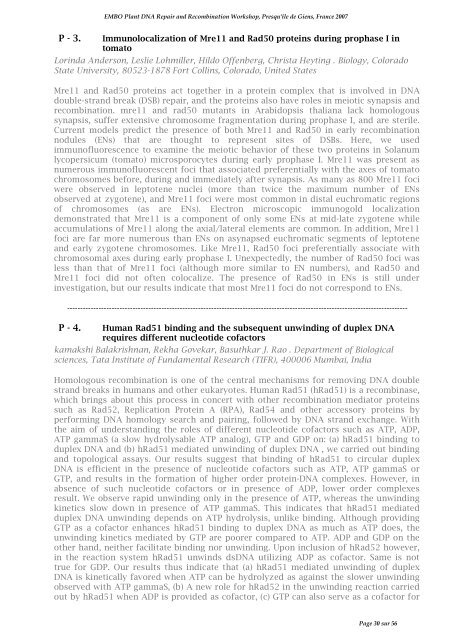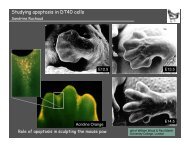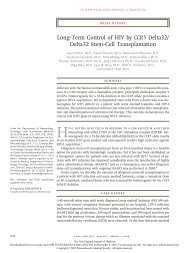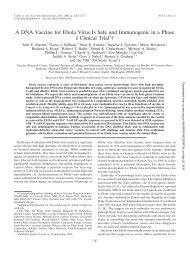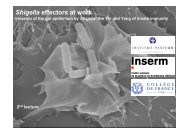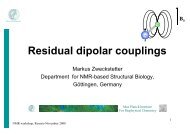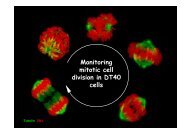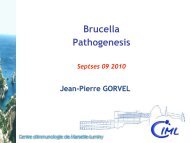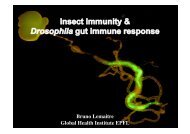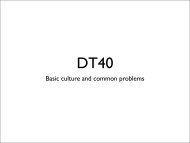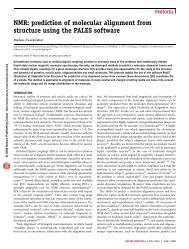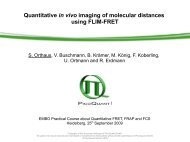pdf file - Events - EMBO
pdf file - Events - EMBO
pdf file - Events - EMBO
You also want an ePaper? Increase the reach of your titles
YUMPU automatically turns print PDFs into web optimized ePapers that Google loves.
<strong>EMBO</strong> Plant DNA Repair and Recombination Workshop, Presqu'île de Giens, France 2007<br />
P - 3. Immunolocalization of Mre11 and Rad50 proteins during prophase I in<br />
tomato<br />
Lorinda Anderson, Leslie Lohmiller, Hildo Offenberg, Christa Heyting . Biology, Colorado<br />
State University, 80523-1878 Fort Collins, Colorado, United States<br />
Mre11 and Rad50 proteins act together in a protein complex that is involved in DNA<br />
double-strand break (DSB) repair, and the proteins also have roles in meiotic synapsis and<br />
recombination. mre11 and rad50 mutants in Arabidopsis thaliana lack homologous<br />
synapsis, suffer extensive chromosome fragmentation during prophase I, and are sterile.<br />
Current models predict the presence of both Mre11 and Rad50 in early recombination<br />
nodules (ENs) that are thought to represent sites of DSBs. Here, we used<br />
immunofluorescence to examine the meiotic behavior of these two proteins in Solanum<br />
lycopersicum (tomato) microsporocytes during early prophase I. Mre11 was present as<br />
numerous immunofluorescent foci that associated preferentially with the axes of tomato<br />
chromosomes before, during and immediately after synapsis. As many as 800 Mre11 foci<br />
were observed in leptotene nuclei (more than twice the maximum number of ENs<br />
observed at zygotene), and Mre11 foci were most common in distal euchromatic regions<br />
of chromosomes (as are ENs). Electron microscopic immunogold localization<br />
demonstrated that Mre11 is a component of only some ENs at mid-late zygotene while<br />
accumulations of Mre11 along the axial/lateral elements are common. In addition, Mre11<br />
foci are far more numerous than ENs on asynapsed euchromatic segments of leptotene<br />
and early zygotene chromosomes. Like Mre11, Rad50 foci preferentially associate with<br />
chromosomal axes during early prophase I. Unexpectedly, the number of Rad50 foci was<br />
less than that of Mre11 foci (although more similar to EN numbers), and Rad50 and<br />
Mre11 foci did not often colocalize. The presence of Rad50 in ENs is still under<br />
investigation, but our results indicate that most Mre11 foci do not correspond to ENs.<br />
----------------------------------------------------------------------------------------------------------------------------------<br />
P - 4. Human Rad51 binding and the subsequent unwinding of duplex DNA<br />
requires different nucleotide cofactors<br />
kamakshi Balakrishnan, Rekha Govekar, Basuthkar J. Rao . Department of Biological<br />
sciences, Tata Institute of Fundamental Research (TIFR), 400006 Mumbai, India<br />
Homologous recombination is one of the central mechanisms for removing DNA double<br />
strand breaks in humans and other eukaryotes. Human Rad51 (hRad51) is a recombinase,<br />
which brings about this process in concert with other recombination mediator proteins<br />
such as Rad52, Replication Protein A (RPA), Rad54 and other accessory proteins by<br />
performing DNA homology search and pairing, followed by DNA strand exchange. With<br />
the aim of understanding the roles of different nucleotide cofactors such as ATP, ADP,<br />
ATP gammaS (a slow hydrolysable ATP analog), GTP and GDP on: (a) hRad51 binding to<br />
duplex DNA and (b) hRad51 mediated unwinding of duplex DNA , we carried out binding<br />
and topological assays. Our results suggest that binding of hRad51 to circular duplex<br />
DNA is efficient in the presence of nucleotide cofactors such as ATP, ATP gammaS or<br />
GTP, and results in the formation of higher order protein-DNA complexes. However, in<br />
absence of such nucleotide cofactors or in presence of ADP, lower order complexes<br />
result. We observe rapid unwinding only in the presence of ATP, whereas the unwinding<br />
kinetics slow down in presence of ATP gammaS. This indicates that hRad51 mediated<br />
duplex DNA unwinding depends on ATP hydrolysis, unlike binding. Although providing<br />
GTP as a cofactor enhances hRad51 binding to duplex DNA as much as ATP does, the<br />
unwinding kinetics mediated by GTP are poorer compared to ATP. ADP and GDP on the<br />
other hand, neither facilitate binding nor unwinding. Upon inclusion of hRad52 however,<br />
in the reaction system hRad51 unwinds dsDNA utilizing ADP as cofactor. Same is not<br />
true for GDP. Our results thus indicate that (a) hRad51 mediated unwinding of duplex<br />
DNA is kinetically favored when ATP can be hydrolyzed as against the slower unwinding<br />
observed with ATP gammaS, (b) A new role for hRad52 in the unwinding reaction carried<br />
out by hRad51 when ADP is provided as cofactor, (c) GTP can also serve as a cofactor for<br />
Page 30 sur 56


